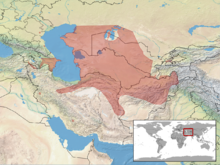Caspian bow finger gecko
| Caspian bow finger gecko | ||||||||||||
|---|---|---|---|---|---|---|---|---|---|---|---|---|

Caspian bow finger gecko ( Tenuidactylus caspius ) |
||||||||||||
| Systematics | ||||||||||||
|
||||||||||||
| Scientific name | ||||||||||||
| Tenuidactylus caspius | ||||||||||||
| ( Eichwald , 1831) |
The Caspian arch finger gecko ( Tenuidactylus caspius , syn .: Cyrtopodion caspium , Cyrtodactylus caspius ), also called Caspian naked finger gecko , is a gecko from the genus Tenuidactylus and lives in western Central Asia.
features
The Caspian arch finger gecko reaches a total length of 16 cm. The head-torso length is around 6 cm on average, a maximum of 7.8 cm for males and a maximum of 6.8 cm for females. The basic color of the top is sand-colored or brownish. There are 5–6 irregular, dark transverse bands on the neck and trunk, which continue in 10–12 transverse stripes on the tail. The underside is whitish. The head and trunk are slightly flattened, the head is relatively large and the trunk is strong. The upper side of the body has 12-16 longitudinal rows of very strong, triangular, keeled hump scales (dorsal tubercles), which are surrounded by numerous small scales. The hump scales extend from the back to the back of the legs to the neck and the back of the head. The tail scales are arranged in whorls, each with a transverse row of very large, strongly keeled, thorny-looking hump scales to the rear. Overall, the hump scales give the animals a rough, prickly appearance. The toes have no differentiated adhesive lamellae and their ends are bent up at an angle (name).
The young animals have significantly fewer (7–8) dark transverse bands on their tails than the adults.
distribution
The distribution area includes some small areas in the Caucasus and on the western shore of the Caspian Sea (here especially in Azerbaijan ), as well as a large, contiguous area from southern Kazakhstan via Turkmenistan and Uzbekistan to northern Iran and east to Afghanistan and Tajikistan . There are other small, disjointed areas in Iran and Tajikistan.
The species was introduced in Georgia (for example in the city of Sukhumi on the Black Sea , in the Russian city of Astrakhan in the Volga region and in the Russian city of Sochi ).
habitat
The Caspian arch finger gecko occurs from sea level up to around 1650 m above sea level (in Afghanistan). In the western part of the area (Caucasus) the species inhabits rocky steep slopes, but also old and dilapidated buildings, e.g. B. in the Dagestani cities of Makhachkala , Buynaksk and Derbent . In Central Asia it can be found on loess slopes, in ravines, on ruins, in rodent burrows and rarely on trees.
Way of life
Hibernation is held from October to February / March . In spring and autumn the animals are also active during the day, in summer they are active at twilight and at night. During the mating season, the males fight turf, which can then be heard with a metallic whistle. The eggs are laid between May and August, with two clutches per female usually being deposited. A clutch consists of two oval, lime-shelled eggs 13 mm long and 8 mm wide, which are glued into cavities or buried in loose sand or loess soil. The young hatch from the end of July until late autumn.
The diet consists of various insects such as bedbugs , cicadas , aphids and beetles . Arachnids and woodlice are also preyed, and in exceptional cases young lizards, e.g. B. Eremias velox . The main predators are snakes and birds such as the black kite .
Danger
The IUCN lists the species as not endangered ( least concern ) with a stable population.
In the greater part of the range the species is common and generally harmless. In Dagestan, however, the species is rare and must be viewed as threatened. Since she lives here especially on old buildings, the rest of the buildings are at great risk from their renovation.
Subspecies
Two subspecies have been described, viz
- T. c. caspius ( Eichwald , 1831) - Almost the entire distribution area
- T. c. insularis ( Akhmedov & Shcherbak , 1978) - Dasch Sirja island in the Caspian Sea
Individual evidence
- ↑ Dieter Glandt: The amphibians and reptiles of Europe: All kinds in portrait. 2nd, updated and expanded edition. Quelle & Meyer, Wiebelsheim 2015, ISBN 978-3-494-01581-1 , pp. 567-569.
- ↑ Tenuidactylus caspius in the Red List of Threatened Species of the IUCN 2017. Posted by: B. Tuniyev, NB Ananjeva, A. Aghasyan, NL Orlov, S. Tuniyev, S. Anderson, M. Chirikova, R. Nazarov & I. Doronin, 2016. Accessed August 14, 2020.
literature
- Dieter Glandt: The amphibians and reptiles of Europe: All kinds in portrait. 2nd, updated and expanded edition. Quelle & Meyer, Wiebelsheim 2015, ISBN 978-3-494-01581-1 , pp. 567-569.
Web links
- Tenuidactylus caspius in The Reptile Database . Edited by: P. Uetz, P. Freed & J. Hošek, 1995–2020. Retrieved August 14, 2020.
- Tenuidactylus caspius in the endangered Red List species the IUCN 2017 Posted by: B. Tuniyev, NB Ananjeva, A. Aghasyan, NL Orlov, S. Tuniyev, S. Anderson, M. Chirikova, R. Nazarov & I. Doronin, 2016 Retrieved August 14, 2020.

